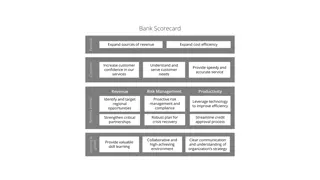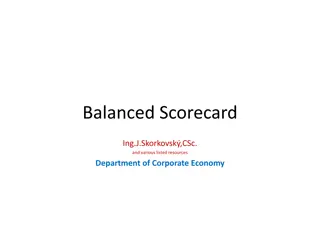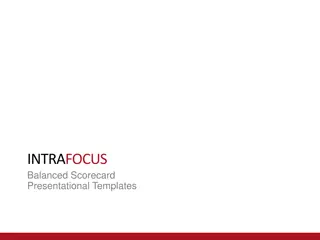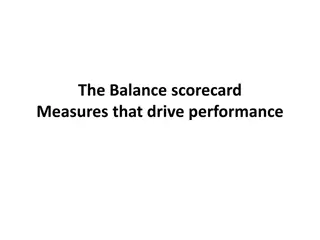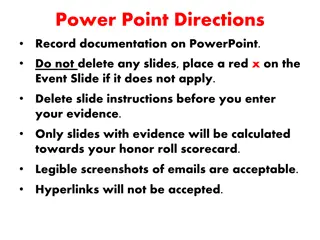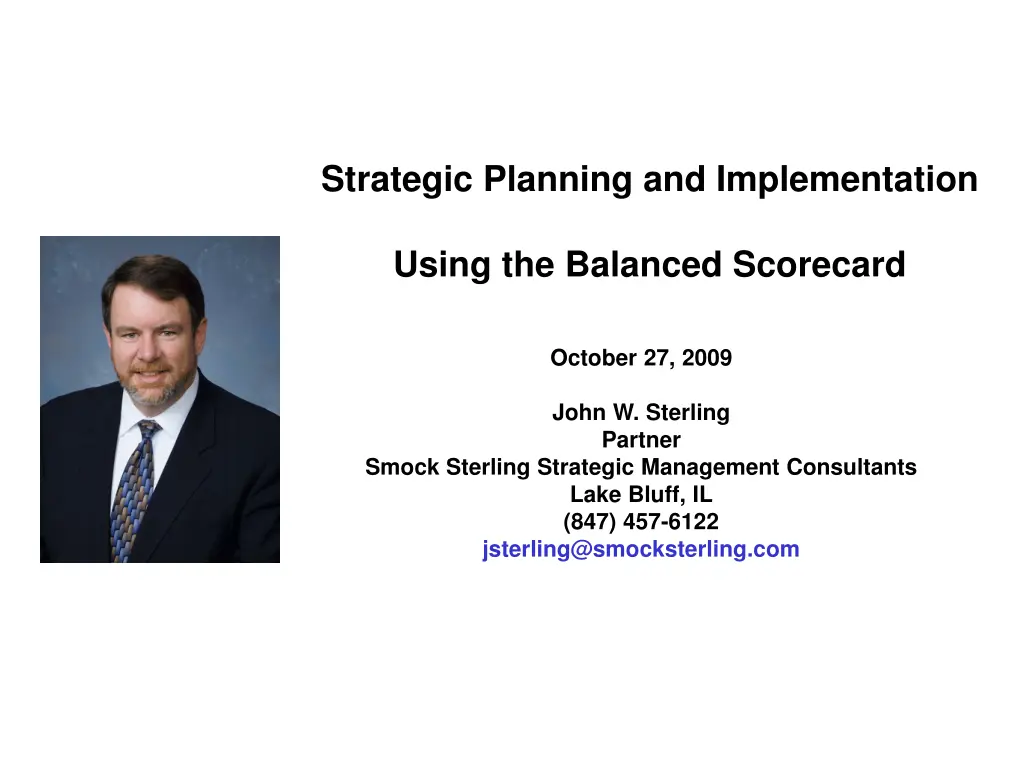
Strategic Planning and Implementation Using Balanced Scorecard
Discover the post-recession balancing act between clients and profits through the Balanced Scorecard tool. Learn about its dimensions, pragmatic steps for professional service firms, and case studies. This strategic planning and implementation guide emphasizes the importance of financial performance and talent retention in a competitive environment.
Download Presentation

Please find below an Image/Link to download the presentation.
The content on the website is provided AS IS for your information and personal use only. It may not be sold, licensed, or shared on other websites without obtaining consent from the author. If you encounter any issues during the download, it is possible that the publisher has removed the file from their server.
You are allowed to download the files provided on this website for personal or commercial use, subject to the condition that they are used lawfully. All files are the property of their respective owners.
The content on the website is provided AS IS for your information and personal use only. It may not be sold, licensed, or shared on other websites without obtaining consent from the author.
E N D
Presentation Transcript
Strategic Planning and Implementation Using the Balanced Scorecard October 27, 2009 John W. Sterling Partner Smock Sterling Strategic Management Consultants Lake Bluff, IL (847) 457-6122 jsterling@smocksterling.com
STRATEGIC PLANNING AND IMPLEMENTATION USING THE BALANCED SCORECARD Post-recession balancing act clients/profits The balanced scorecard a tool designed for this issue What it is and how it works Looking at the four dimensions Pragmatic steps to using the tool in a professional service firm Case studies (time permitting) Q&A
STRATEGIC PLANNING AND IMPLEMENTATION USING THE BALANCED SCORECARD THE BALANCING ACT
STRATEGIC PLANNING AND IMPLEMENTATION USING THE BALANCED SCORECARD The Post-Recession Balancing Act
STRATEGIC PLANNING AND IMPLEMENTATION USING THE BALANCED SCORECARD The Post-Recession Balancing Act (Cont d) The recession has had an impact on clients expectations of value (i.e., results costs) Persistent rate increases drove profit growth Entry level starting pay highly visible and seemingly irrational Quality mid-size firms are proving to be capable Meanwhile, partner mobility has increased for a decade following the recession it is fair to expect that mobility will return (particularly for those with strong client relationships) Financial performance matters in the battle for talent Thus, profit growth must return and it is less and less likely to come simply from rate increases
STRATEGIC PLANNING AND IMPLEMENTATION USING THE BALANCED SCORECARD The Post-Recession Balancing Act (Cont d) Strategic planning and implementation need to balance the needs and expectations of these two key stakeholders Clients Shareholders/partners The balanced scorecard was developed specifically with this need in mind
STRATEGIC PLANNING AND IMPLEMENTATION USING THE BALANCED SCORECARD BALANCED SCORECARD AN INTRODUCTION
STRATEGIC PLANNING AND IMPLEMENTATION USING THE BALANCED SCORECARD The Balanced Scorecard An Overview Financial Financial Financial To succeed financially, To succeed financially, how should we appear how should we appear To succeed financially, how should we appear to our shareholders? to our shareholders? to our shareholders? Internal Business Processes To satisfy our shareholders and customers, what Internal Business Processes To satisfy our shareholders and customers, what business processes business processes Internal Business Processes To satisfy our shareholders and customers, what business processes must we excel at? must we excel at? must we excel at? Customer To achieve our vision, Customer To achieve our vision, how should we appear how should we appear Customer To achieve our vision, how should we appear to our customers? to our customers? to our customers? Vision and Strategy Strategy Strategy Vision Vision and and Learning and Growth To achieve our vision, how will we sustain our Learning and Growth To achieve our vision, how will we sustain our ability to change and ability to change and Learning and Growth To achieve our vision, how will we sustain our ability to change and improve? improve? improve?
STRATEGIC PLANNING AND IMPLEMENTATION USING THE BALANCED SCORECARD The Balanced Scorecard An Overview (Cont d)
STRATEGIC PLANNING AND IMPLEMENTATION USING THE BALANCED SCORECARD The Balanced Scorecard Financial Dimensions The importance of (obsession with) PPEP grew steadily over the past decade PPEP is a legitimate measure of financial performance and it has become the de facto yardstick Remember there is a numerator and a denominator
STRATEGIC PLANNING AND IMPLEMENTATION USING THE BALANCED SCORECARD The Balanced Scorecard Financial Dimensions (Cont d) The numerator has many levers Realization Realization Hours/ Productivity Productivity Hours/ Billing Rates Billing Rates Firm Profitability Firm Profitability Costs Costs Leverage Leverage
STRATEGIC PLANNING AND IMPLEMENTATION USING THE BALANCED SCORECARD The Balanced Scorecard Financial Dimensions (Cont d) The denominator has one lever the number of equity partners The euphemism for managing the denominator financial engineering is just another way of saying de-equitization and/or firing partners It is reasonable to expect the business model to change in the coming years and to expect equity ranks to continue to tighten But, the balanced scorecard (and strategy development more broadly) is not about managing the denominator
STRATEGIC PLANNING AND IMPLEMENTATION USING THE BALANCED SCORECARD The Balanced Scorecard Client Dimension What do we (want to) look like to our clients? How do we know when we have achieved that? Client diversification (breadth and diversity of client relationships) Number of clients at defined threshold No clients representing defined percentage of fees Large/Institutional relationship % of fees from large transactions/cases % of fees from clients over threshold level Increase in number of large relationships Depth and breadth of relationships Client satisfaction scores/feedback Third party rankings
STRATEGIC PLANNING AND IMPLEMENTATION USING THE BALANCED SCORECARD The Balanced Scorecard Client Dimension (Cont d) Key Findings from all 4 Firms Area of Law Count Clients with work in only one Area of Law have a much higher attrition rate than those with more breadth of work higher attrition rate than those with more breadth of work Key Findings from all 4 Firms Area of Law Count Clients with work in only one Area of Law have a much Firm 1 Firm 1 Firm 2 Firm 2 40% 40% 16% 16% 35% 35% 14% 14% 30% 30% 12% 12% 25% 25% 10% 10% 20% 20% 8% 8% 15% 15% 6% 6% 10% 10% 4% 4% Attrition Rate Attrition Rate 5% 5% 2% 2% 0% 0% 0% 0% 1 1 2 2 3 3 4 4 5+ 5+ 1 1 2 2 3 3 4 4 5+ 5+ Firm 3 Firm 3 Firm 4 Firm 4 14% 14% 35% 35% 12% 12% 30% 30% 10% 10% 25% 25% 8% 8% 20% 20% 6% 6% 15% 15% 4% 4% 10% 10% 2% 2% 5% 5% 0% 0% 0% 0% 1 1 2 2 3 3 4 4 5+ 5+ 1 1 2 2 3 3 4 4 5+ 5+ Source: Redwood Analytics
STRATEGIC PLANNING AND IMPLEMENTATION USING THE BALANCED SCORECARD The Balanced Scorecard Client Dimension (Cont d) Key Findings from all 4 Firms - Partner Count Clients who have more partners involved in their relationships have lower rates of attrition have lower rates of attrition Key Findings from all 4 Firms - Partner Count Clients who have more partners involved in their relationships Firm 1 Firm 1 Firm 2 Firm 2 40% 40% 16% 16% 35% 35% 14% 14% 30% 30% 12% 12% 25% 25% 10% 10% 20% 20% 8% 8% 15% 15% 6% 6% 10% 10% 4% 4% Attrition Rate Attrition Rate 5% 5% 2% 2% 0% 0% 0% 0% 0 0 1 1 2 2 3 3 4 4 5+ 5+ 0 0 1 1 2 2 3 3 4 4 5+ 5+ Firm 3 Firm 3 Firm 4 Firm 4 20% 20% 60% 60% 50% 50% 15% 15% 40% 40% 10% 10% 30% 30% 20% 20% 5% 5% 10% 10% 0% 0% 0% 0% 0 0 1 1 2 2 3 3 4 4 5+ 5+ 0 0 1 1 2 2 3 3 4 4 5+ 5+ Source: Redwood Analytics
STRATEGIC PLANNING AND IMPLEMENTATION USING THE BALANCED SCORECARD The Balanced Scorecard Client Dimension (Cont d) Market Penetration Strategy (More of the Same Status Quo 95%) Status Quo 95%) Market Penetration Strategy (More of the Same Product Development Strategy (50% Probability of Success) Success) Product Development Strategy (50% Probability of Existing Clients Market Development Strategy (25% Probability of Success) Success) Market Development Strategy (25% Probability of Diversification Strategy (5% Probability of Success) Success) Diversification Strategy (5% Probability of New Clients Existing Services New Services Source: Stanford Research Institute
STRATEGIC PLANNING AND IMPLEMENTATION USING THE BALANCED SCORECARD The Balanced Scorecard Business Process Dimension Focus should be on processes that have a genuine impact on financial performance, on client satisfaction/experiences, or ideally on both fronts Remember the demise of TQM and Clients First programs Most meaningful business processes occur in one of two places in a law firm In practice groups the closer to the delivery of services, the more meaningful the process In administrative functions accounting, procurement, technology management, etc. Time capture, billing and collection cycles are often low hanging fruit and link directly to realization
STRATEGIC PLANNING AND IMPLEMENTATION USING THE BALANCED SCORECARD The Balanced Scorecard Business Process Dimension (Cont d) A brief word about alternative fee approaches Understand your costs Understand the clients motivations Saving money Predictability Shared risk Business process is integral to aligning the two (costs and client motivations) the solution is a by-product of that analysis
STRATEGIC PLANNING AND IMPLEMENTATION USING THE BALANCED SCORECARD The Balanced Scorecard People and Capabilities Learning and growth is about people, capabilities and tools that support them People measures are often (too often) soft Some hard (and hard to achieve) measures Associate recruiting and retention statistics/targets Diversity statistics and targets (relative to competition) Equity partner performance and standards External recognition Organizational capability analyses gap analysis can focus and prioritize resources and initiatives
STRATEGIC PLANNING AND IMPLEMENTATION USING THE BALANCED SCORECARD The Balanced Scorecard People and Capabilities (Cont d) Current State OCA Desired End State Superior Superior 30 30 31 31 21 21 Superior Superior 29 29 9 9 28 28 24 24 10 10 7 7 16 16 22 22 2 2 1 1 10 10 RELATIVE CAPABILITY RELATIVE CAPABILITY 20 20 31 31 33 33 2 2 1 1 18 19 18 19 28 28 4 4 5 5 30 30 11 11 14 14 11 11 25 25 1819 1819 4 4 8 8 15 15 23 23 29 29 22 22 7 7 Parity Parity 32 32 27 27 RELATIVE CAPABILITY RELATIVE CAPABILITY 32 32 27 27 13 13 3 3 24 24 12 12 9 9 8 8 15 15 20 20 33 33 5 5 Parity Parity 17 17 26 26 23 23 21 21 12 12 13 13 6 6 16 16 25 25 6 6 Worse Worse 3 3 14 14 17 17 26 26 Worse Worse Must Have/Threshold Must Have/Threshold Distinguishing Distinguishing Differentiating Differentiating CRITICALITY CRITICALITY Must Have/Threshold Must Have/Threshold Distinguishing Distinguishing Differentiating Differentiating CRITICALITY CRITICALITY
STRATEGIC PLANNING AND IMPLEMENTATION USING THE BALANCED SCORECARD APPLYING THE CONCEPT A PRAGMATIC APPROACH
STRATEGIC PLANNING AND IMPLEMENTATION USING THE BALANCED SCORECARD Pragmatic Approach for Firms First, get a strategic plan, then Firm level planning involves some basic steps Analytical rigor internal and external environment Vision and direction setting Strategic positioning where we intend to win Strategy development high level resource allocation Implementation plugging in the balanced scorecard Articulate high level objectives or targets for profitability and client relationships Express it simply get it on one page
STRATEGIC PLANNING AND IMPLEMENTATION USING THE BALANCED SCORECARD Pragmatic Approach for Firms One Page Plan High Level Strategies High Level Strategies Primary Excellence Goals Primary Excellence Goals High Level Strategies High Level Strategies Mission Mission Primary Excellence Goals Primary Excellence Goals Vision Core Purposes Vision Core Purposes Core Values Core Values High Level Strategies High Level Strategies Primary Excellence Goals Primary Excellence Goals High Level Strategies High Level Strategies Primary Excellence Goals Primary Excellence Goals
STRATEGIC PLANNING AND IMPLEMENTATION USING THE BALANCED SCORECARD Pragmatic Approach for Firms Engage the Practices Ultimately, implementation must involve the practice groups Balanced scorecard tools were developed with business units (shared customers, shared products, shared processes) in mind Engage the practices by mapping the firm s strategy to each practice group this can be top down or bottom up Customize practice portfolio management tools to make it transparent and easy to use
STRATEGIC PLANNING AND IMPLEMENTATION USING THE BALANCED SCORECARD Pragmatic Approach for Firms Engage the Practices (Cont d)
STRATEGIC PLANNING AND IMPLEMENTATION USING THE BALANCED SCORECARD Pragmatic Approach for Firms Engage the Practices (Cont d) The practices then drive implementation via the use of balanced scorecard tools Direct actions related to financial performance Direct actions related to client and business development (external and cross-marketing) Direct action related to people/professional development Process improvement focus/initiatives Set near term targets in each area Denote champions or owners for each initiative Meet, monitor and discuss the results
STRATEGIC PLANNING AND IMPLEMENTATION USING THE BALANCED SCORECARD Pragmatic Approach for Firms A Continuing Cycle Regular dialog and discussion consultation to the practices and assistance from administration Adjustment based on outcomes of firm strategies and underlying assumptions Annual planning at the practice level in line with budgeting
STRATEGIC PLANNING AND IMPLEMENTATION USING THE BALANCED SCORECARD Pragmatic Approach for Firms A Continuing Cycle (Cont d) Clarifying and Translating the Vision and Strategy Clarifying the vision Gaining consensus Gaining consensus Clarifying and Translating the Vision and Strategy Clarifying the vision Communicating and Linking Communicating and educating Setting goals Linking rewards to performance measures performance measures Communicating and Linking Communicating and educating Setting goals Linking rewards to Strategic Feedback and Learning Articulating the shared vision Supplying strategic feedback Facilitating strategy review and learning review and learning Strategic Feedback and Learning Articulating the shared vision Supplying strategic feedback Facilitating strategy Balanced Scorecard Scorecard Scorecard Balanced Balanced Planning and Target Setting Setting targets Aligning strategic initiatives Allocating resources Establishing milestones Establishing milestones Planning and Target Setting Setting targets Aligning strategic initiatives Allocating resources
STRATEGIC PLANNING AND IMPLEMENTATION USING THE BALANCED SCORECARD CASE STUDIES
STRATEGIC PLANNING AND IMPLEMENTATION USING THE BALANCED SCORECARD Case Studies Mallesons Stephen Jaques Australia and Pacific Rim Return to #1 ranking in client satisfaction Objective drivers of client satisfaction identified Getting a lawyer on the phone on the first call Development of PeopleFinder tool Results 10,000 fewer VM, 1 million hits on PeopleFinder, #1 on BRW Client Choice Awards
STRATEGIC PLANNING AND IMPLEMENTATION USING THE BALANCED SCORECARD Case Studies (Cont d) Bryan Cave US Based, global law firm Balance of financial and client at center of strategy Desktop tool development right people on the matters Cost control, margin management, high satisfaction Results 70% tool usage (including newly integrated PoGo lawyers); gains on every objective target
STRATEGIC PLANNING AND IMPLEMENTATION USING THE BALANCED SCORECARD QUESTIONS













